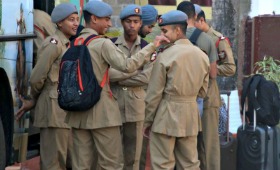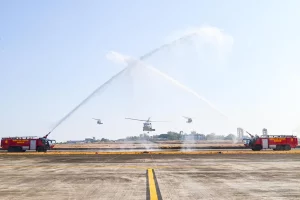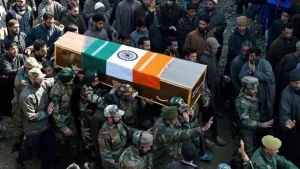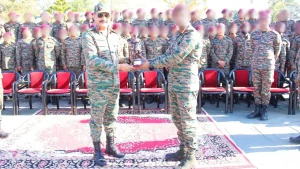Candidates must be physically fit according to NDA physical standards for National Defence Academy admission to National Defence Academy and Naval Academy Examination as per the nda exam eligibility guidelines given following defects or ailments should not found in a candidate otherwise he will fail the nda exam eligibility criteria:
- Wax ( Ears )
- Deviated Nasal Septum
- Hydrocele / Phimosis
- Overweight / Underweight
- Under sized Chest
- Piles
- Gynaecomastia
- Tonsillitis
- Varicocele
NDA 2017 Online Coaching
Height Weight Requirement for NDA 2 2017 Entry
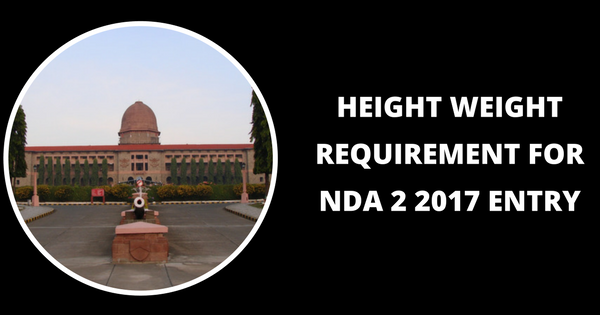
(a) The candidate must be in good physical and mental health and free from any disease/disability which is likely to interfere with the efficient performance of Military duties.
(b) There should be no evidence of weak constitution, bodily defects or under weight. The Candidate should not be overweight or obese.
(c) The minimum acceptable height is 157 cms(162.5 cms. for Air Force). For Gorkhas and individuals belonging to hills of North-Eastern regions of India, Garhwal and Kumaon, the minimum acceptable heights will be 5 cms. less. In case of candidates from Lakshadweep the minimum acceptable height can be reduced by 2 cms. Height and weight standards are given below :
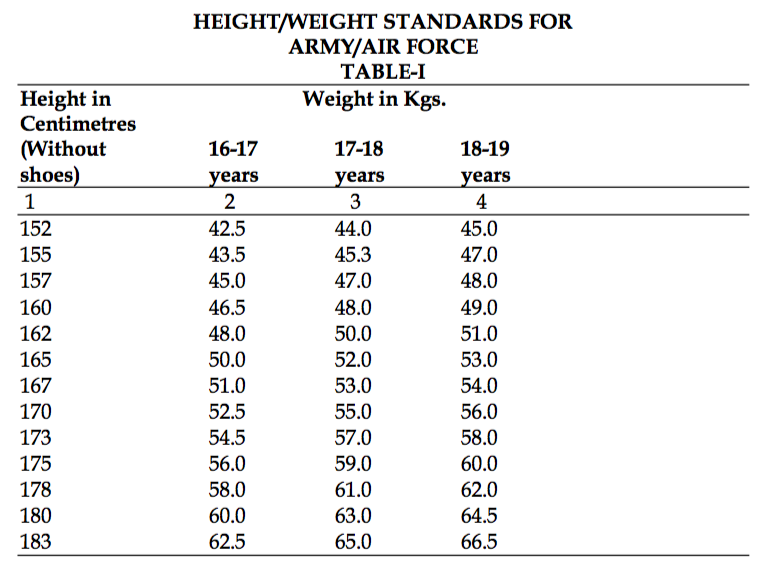
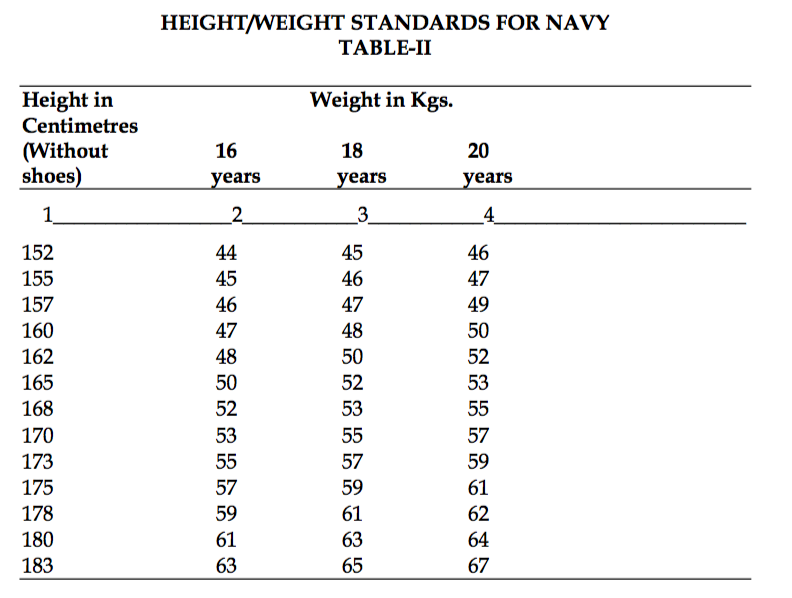
“Individual’s weight is considered normal if it is within ±10% departure from average weight given in the table I and II”. However, in individuals with heavy bones and broad build as well as individuals with thin build but otherwise healthy this may be relaxed to some extent on merit.
NOTE 1 : Height relaxable upto 2.5 cm. (5 cm. for Navy) may be allowed where the Medical Board certifies that the candidate is likely to grow and come up to the required standard on completion of his training.
NOTE 2 : To meet special requirement as a pilot in the Air Force the acceptable measurements of leg length, thigh length and sitting height will be as under :
(d) Chest should be well developed. Fully expanded chest should not be less than 81 cms. The minimum range of expansion after full inspiration should be 5 cms. The measurement will be taken with a tape so adjusted that its lower edge should touch the nipple in front and the upper part of the tape should touch the lower angle of the shoulder blades behind. X-Ray of the chest is compulsory and will be taken to rule out any disease of the chest.
(e) There should be no maldevelopment or impairment of function of the bones or joint.
Spinal Conditions
(f) Past medical history of diseases or injury of the spine or sacro iliac joints, either with or without objective signs which have prevented the candidate from successfully following a physically active life, is a cause for rejection for commissioning in IAF. History of spinal fracture/prolapsed intervertebral disc and surgical treatment for these conditions will entail rejection. The following conditions detected radiologically during medical exam will disqualify a candidate for Air Force service:
- Granulomatous disease of spine (ii) Arthritidies/spondylosis
- Rheumatoid arthritis and allied disorders
- Ankylosing spondylitis
- Osteoarthrosis, spondylosis and degenerative joint disease
- Non articular rheumatism (e.g. lesions of the rotator cuff, tennis elbow, recurrent lumbago etc.)
- Miscellaneous disorders including SLE, , polymyositis, vasculitis.
- Spondylolisthesis/spondylolysis.
- Compression fracture of vertebrae.
- Scheuerman’s disease (Adolescent kyphosis)
- Loss of cervical lordosis when associated with clinically restricted movements of cervical spine.
- Unilateral/Bilateral cervical ribs with demonstrable neurological or circulatory deficit.
- Scoliosis more than 15 degree as measured by Cobb’s method.
- Degenerative Disc. Disease.
- Presence of schmorl’s nodes at more than one level.
- Atlanto-occipital and atlantoaxial anomalies.
- Hemi vertebrae and/or incomplete block (fused) vertebrae at any level in cervical, dorsal or lumbar spine and complete block (fused) vertebrae at more than one level in cervical or dorsal spine.
- Unilateral Sacralisation or lumbarisation (Complete or incomplete) at all levels and bilateral incomplete sacralisation or lumbarisation.
- Any other abnormality if so considered by the specialist.
(g) Mild Kyphosis or Lordosis where deformity is barely noticeable and there is no pain or restriction of movement will not preclude acceptance.
(h) In case of noticeable Scoliosis or suspicion of any other abnormality or spinal deformity, more than mild, appropriate X-rays of the spine are to be taken and the Examinee referred for specialist’s advice.
(i) The following conditions detected on X-ray examination will be disqualifying for entry to Armed Forces :
- Granulomatius disease of spine. Arthritidies/spondylosis
- Scoliosis more than 15 degree as measured by Cobb’s Method (10 degree for Army).
- More than mild Kyphosis/Lordosis Spondylolisthesis/Spondylosis/Spondylolysis
- Herniated nucleus pulposes. Compression fracture of Vertebra.
- Sacaralisation Disease
- Cervical ribs with demonstrable neurological or Circulatory deficit.
- Presence of Schmorl’s node at more than one level. Atlanto-occipital and atlanto-axial anomalies.
- Incomplete Sacaralisation Unilateral or Bilateral
Spina Bifida other than SV 1 and LV 5 if completely Sacralised Any other abnormality, if so considered by specialist.
(j) A candidate should have no past history of mental breakdown or fits.
(k) The hearing should be normal. A candidate should be able to hear a forced whisper with each ear at a distance of 610 cms. in a quiet room. There should be no evidence of present or past disease of the ear, nose and throat. Audiometric test will be done for AF. Audiometric hearing loss should not be greater than 20 db in frequencies between 250 and 8000 Hz. There is no impediment of speech.
(l) There should be no signs of functional or organic disease of the heart and blood vessels. Blood pressure should be normal.
(m) There should be no enlargement of liver or spleen. Any evidence of disease of internal organs of the abdomen will be a cause for rejection.
(n) Un-operated hernias will make a candidate unfit. In case of Hernia which has been operated, a minimum of 6 months must have passed prior to final medical examination before commencement of the course.
(o) There should be no hydrocele, varicocele or piles.
(p) Urine examination will be done and any abnormality if detected will be a cause for rejection.
(q) Any disease of skin which is likely to cause disability or disfigurement will also be a cause for rejection.
(r) Visual standards:- The distance vision (corrected) should be 6/6 in better eye and 6/9 in worse eye. Myopia should not be more than 2.5 D and hypermetropia not more than 3.5 D including Astigmatism. Internal examination of the eye will be done by means of opthalmoscope to rule out any disease of the eye. A candidate must have good binocular vision. The colour vision standard will be (CP-III) for Army. A candidate should be able to recognise red and green colours. Candidates will be required to give certificates that neither he nor any member of his family has suffered from congenital night blindness. Candidates who have undergone or have the evidence of having undergone Radial Keratotomy, to improve the visual acuity will be permanently rejected for all the Services. Candidates who have undergone Laser Surgery for correction of refractive error are also not acceptable to defence services.
(t) The candidates should have sufficient number of natural and sound teeth. A minimum of 14 dental points will be acceptable. When 32 teeth are present, the total dental points are 22. A candidate should not be suffering from severe pyorrhoea.
